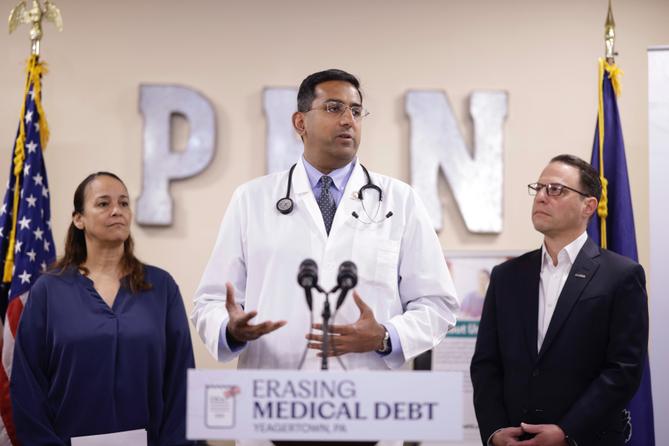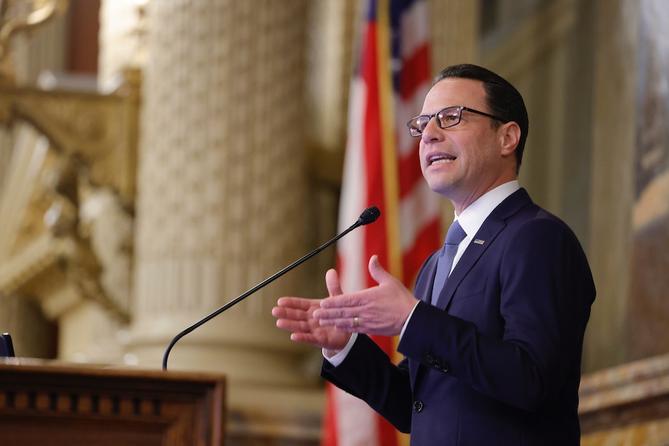HARRISBURG — Low-income Pennsylvanians could lose access to medical coverage for popular weight-loss drugs like Ozempic and Wegovy as state lawmakers search for savings in this year’s state budget talks.
But while there’s a consensus in Harrisburg that the commonwealth needs to save money on these drugs, known as GLP-1s, lawmakers’ preferred approaches vary.
Democratic Gov. Josh Shapiro’s administration says it plans to unilaterally change guidelines in Pennsylvania's Medicaid program starting as early as this summer to reduce patients’ ability to use GLP-1s for weight loss. Leaders in the GOP-controlled state Senate say they also want to cut these costs, though haven’t specifically said how.
A bipartisan group of state House lawmakers meanwhile favors having Pennsylvania negotiating with manufacturers for lower prices while preserving Medicaid recipients’ ability to access the drugs.
GLP-1s have for two decades been prescribed to treat diabetes. But in recent years, doctors have increasingly authorized them to help people lose weight, including low-income patients covered by Pennsylvania’s Medicaid program, known as Medical Assistance.
The plan has covered these drugs for diabetes for years. In 2022, the commonwealth spent $222 million on GLP-1s, according to data provided by the state Department of Human Services, which oversees Medical Assistance.
Then in 2023, the department added coverage of GLP-1s for weight loss. It is one of 13 states to do so, according to KFF, a health policy research organization. Since then, the cost of the treatment has increased exponentially.
To cover 70,000 recipients prescribed these medications for any reason in 2024 — from diabetes to weight loss — the department spent $650 million. It projects it will spend $1.3 billion in 2025.
To address this rising cost, the Shapiro administration has proposed making Medical Assistance only cover weight-loss-related GLP-1s for patients above a certain body mass index, or for those with a high BMI who must lose weight due to chronic conditions like high blood pressure or heart disease.
While a document included a proposed start date of July 7, 2025 for the new policy, a DHS spokesperson added in a subsequent email that the agency “will announce an implementation when plans are finalized, and there will be at least a month of lead time.”
Use of the drugs for weight loss alone will no longer be covered for patients who are under those new thresholds.
Currently, the department does not set a BMI threshold or treat prescriptions for underlying conditions any differently than ones exclusively for weight loss.
“We are evaluating changes to the current medical necessity guidelines for GLP-1s to ensure the medications are used appropriately by those who need it most, while considering cost effectiveness by limiting access based on body mass index or other health factors,” DHS secretary Val Arkoosh told House lawmakers during spring budget hearings.
A DHS spokesperson did not offer projected cost savings for reducing access to the medications, or provide an estimate of how many people would be affected.
But any reduction in Medicaid spending will be welcomed by state Senate Republicans, who have said that slowing the state’s spending is a top priority this year.
“Medicaid was supposed to be a safety net program, and what happens is, if you keep adding in new things that cost you, especially in the category of billions of dollars … it starts to harm other services,” Senate Appropriations Committee Chair Scott Martin (R., Lancaster) told Spotlight PA in April.
Pennsylvania has surplus cash in the bank, roughly $11 billion built up due to pandemic-era federal aid. But the state also has a longstanding structural deficit, consistently spending more than it makes in revenue. Much of that spending is driven by rising health care costs for the state’s aging population.
Just paying for Shapiro’s $51 billion spending plan, which includes the proposed eligibility reduction, would use $4.6 billion of the state’s surplus.
And with so many competing spending priorities in this year’s budget talks, any dollars saved in one area, like Medicaid, means dollars freed for something else.
Martin floated that those savings could be used to invest elsewhere in public health, such as covering disability or elder care. Democrats have two expensive goals on the table this year: fulfilling a court mandate to improve public education and saving public transit agencies from a fiscal cliff.
But while Republicans in the state Senate are happy to let the Shapiro administration use its authority to cut Medicaid costs, a different opinion has emerged in the state House — that the real cost savings are to be had by proactively treating obesity and avoiding the longer-term expenses of chronic illness, such as high blood pressure and heart disease.

“We are essentially restricting this medication to a level where people will suffer significant medical consequences before they can be on the medication,” state Rep. Arvind Venkat (D., Allegheny), a practicing emergency room physician, told Spotlight PA of the administration’s approach.
“Don't we want to prevent people from getting to that level of obesity when we know the consequences?” he asked. “Don't we want to prevent the medical consequences of obesity?”
Last month, Venkat introduced a bill with state Rep. Bryan Cutler (R., Lancaster) — a former GOP House Speaker and health care wonk — that would require DHS to negotiate a better price for GLP-1s directly with drug manufacturers. That approach, he said, would allow Pennsylvania to preserve access for Medicaid patients while still lowering the state’s skyrocketing costs.
Specifically, Venkat thinks the state should follow a subscription model in which it comes to an agreement with each drug manufacturer and pays a fixed, annual price to acquire doses of their GLP-1 drug. In a memo to his colleagues, Venkat compared it to a “Netflix model.” This would give Pennsylvania access to the drug at that price for a set period of time.
These models guarantee financial certainty for purchasers and recurring revenue for manufacturers, according to an April white paper from the Institute for Clinical and Economic Review, a Boston-based health care think tank.
However, the paper found some difficulties with the model. While “some large purchasers had explored a subscription model in discussions with drugmakers,” the authors wrote, ultimately “there was little interest” among those purchasers in pursuing a subscription model, given the high demand for GLP-1 medications and “the acknowledged administrative burden of setting up a subscription model.”
Still, the paper concluded that “change is needed, [and] there is no easy script for all to follow.”
In a statement, a spokesperson for Ozempic manufacturer Novo Nordisk only said that the company has “been working closely with policymakers in Pennsylvania” to ensure continued access.
Venkat told Spotlight PA that the Shapiro administration has refused to hear him out on the proposal despite its bipartisan support.
In an email, a DHS spokesperson did not dispute that characterization of the administration’s skepticism.
The department has already negotiated some discounts with drug manufacturers, the spokesperson said, but GLP-1s remain expensive, “which is why DHS is proposing changes.”
Pennsylvania isn’t alone in facing ballooning drug costs, and the problem is not unique to publicly funded health care.
Insurers across the country are struggling with how to pay for the meteoric increase in use of GLP-1s by millions of Americans. Multiple states have sought to save money by cutting weight-loss drugs from their private health plans for state employees; one private Massachusetts insurer reported $400 million in losses in 2024 partially because of increased GLP-1 prescribing.
That means medical plans that include Ozempic and its cousins aren't the default.
According to data compiled by LEVERAGE | AXIACI, a consulting firm, half of Pennsylvanians’ health insurance plans cover the drugs for weight-loss purposes. And while Medicaid recipients are covered, the plans that most state employees receive do not typically include coverage of GLP-1s for weight loss.
However, there is one notable exception — state legislators and their staff.
In an email, Erica Clayton Wright, spokesperson for state Senate President Pro Tempore Kim Ward (R., Westmoreland) confirmed that Senate benefits currently cover GLP-1s, “however GLP-1’s for weight loss will no longer be covered as of July 1, 2025.”
Jennifer Benko, the comptroller of the state House, also confirmed that the chamber’s health plan covers the medications, but did not answer any follow-up questions.
Spokespeople for House Democratic leadership did not respond to questions about the caucus’s stance on GLP-1 coverage, either for themselves or for Medicaid recipients.
The state budget is due June 30.
